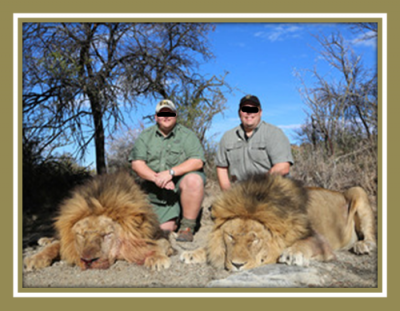|

A number of conservation organizations submitted a proposal to the US Government on the 1st March 2011 for the US Fish and Wildlife Service to consider African lions as an endangered species, thereby preventing all further lion product imports into the USA.
Of course, the biggest “lion product import” is lion trophies that US citizens are highly engaged in collecting all over Africa.
Progress of the petition was glacial. In November 2012 (20 months later) the USFWS said the proposal “had merit” and called for further deliberations. On 27th November 2014 the USFWS announced that they proposed a listing of “threatened” for African lions and would require another 90 day period for public submissions to proceed to actually have African lions listed as such.
It took the USFWS about 45 months to come to this conclusion, and now another 3 months to evaluate and probably another 6 months to finalize.
Where did it all go so wrong?
I would evaluate this as follows:
- Pro-hunting organizations like SCI and DSC raised a “war chest” in excess of $1.2 million to lobby and engage with their sympathetic scientists.
- The USFWS accepted highly dubious lion population numbers remaining in Africa. For example, they accepted population estimates from a French pro-hunting organization, two IUCN estimates based on opinions from delegates at lion meetings, a Duke University estimate based on remote sensing. As a result, the USFWS was led to believe, based on satellite imagery of “available” lion habitat and postal questionnaires that there are something like 32,000 lions in Africa.
- All actual ground surveys have come up with far fewer lions. The total is more like 15,000.
- The USFWS rejected information to consider western African lions as a separate genetic entity. They only accept that there are African lions and Asian lions. This is a highly selective interpretation, and dismissive of highly convincing and replicated genetic evidence.
- The USFWS employs a number of scientists. Doubtless they are busy on a daily basis to advise on various issues, but equally they should engage with the opinions of other international scientists. Those in the European Union have designated western African lions as “highly endangered” while the USFWS seesm to have some different opinion. Australia will no longer allow lion product imports as Australian scientists consider African lions endangered.
- The USFWS accepts that “conservation hunting” of lions is not a threat. Surprising, as there has not been a SINGLE survey of lion populations in hunting concessions. The hunters do not allow independent surveys in concessions. The USFWS does, strangely, not accept that trophy hunting has significant consequences on lion social structure and future reproductive potential… (????).
- The USFWS has after 45 months not conducted due diligence in terms of a real assessment of the threats to lions from US trophy hunters. However… they now have made a compromise to scrutinize future trophy imports based on a requirement of exporting countries to have scientifically based lion conservation programmes in place and that the expenditure of hunting related revenue is proven to be spent directly on lion conservation. Also, the USFWS decided to propose what is known as a 4(d) rule for the lion. The rule, if finalized, “will establish a permitting mechanism to allow importation of sport-hunted African lion trophies into the United States PROVIDED that they are established as originating from countries with a scientifically sound management plan for the African lion.” I would argue that, as of today, that will not include Zimbabwe, Tanzania, Mozambique, Cameroon, Central African Republic and others where US trophy hunters, the hunting operators and indeed the governments pay little more than lip service to lion conservation. None of these countries has a scientifically based lion conservation programme in place and none of these countries have therefore attended to the USFWS requirement of regular lion population surveys. A national lion conservation plan by an African nation, unless paid attention to, is not worth the paper it is written on, and the USFWS will have difficulty establishing how well such plans are implemented.
- The USFWS does not consider with any necessary concern the huge captive lion trophy hunting industry in South Africa. This is again a deplorable oversight. While captive raised lions offered for trophy hunting are not equivalent to wild lions, the USFWS should have addressed this issue with due attention. The USFWS is opposed to the captive breeding of tigers in China and prohibits all such resulting products as US imports. The USFWS should treat captive bred lions with the same level of prohibitions.
- The USFWS still believes that trophy hunting of lions is beneficial to conservation of the species. In that case, why did the USFWS place a moratorium on trophy hunting imports of elephants from Tanzania and Zimbabwe citing a lack of conservation contribution of trophy hunting? What is good for the goose should be good for the gander.
So where do we go from here?
The Safari Club International is calling for funding to overturn the need for there to be ANY national conservation plan for lions in the countries where they are hunted. Meanwhile, LionAid will write to the USFWS with our concerns about their conclusions, but we do not have the funds to travel to Washington to lobby more effectively. The current USFWS plan will likely go through, and the current public comment period is likely not much more than window dressing.
Meanwhile, LionAid will continue to push for much better restrictions on lion trophy imports within the EU, and we will also continue to push hard for lion hunting moratoria in the exporting countries. Perhaps the USFWS was always a bridge too far?
If you have not already signed up to our mailing list, you can add your name here and keep up to date with our ongoing work and, most importantly, DONATE to support our work to conserve the remaining fragile lion populations.
|




